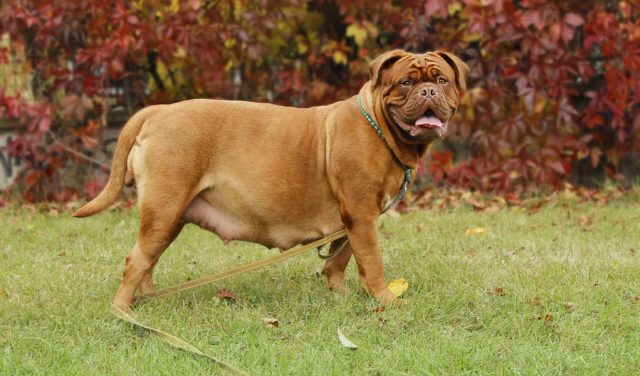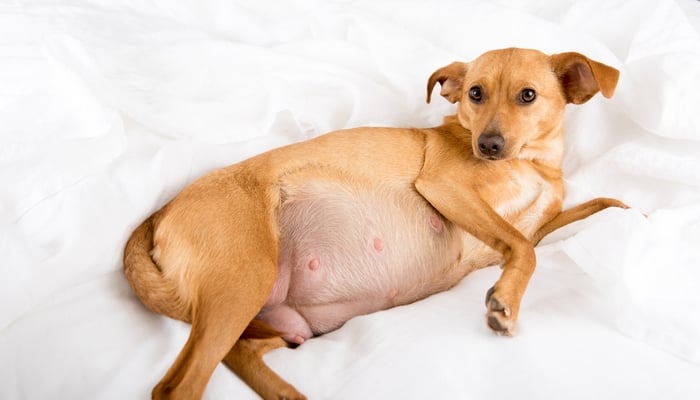
Table of Contents
While it is not as difficult as preparing for your own pregnancy, there are steps that you should take to prepare for your dog’s pregnancy that will make things go a bit smoother. As with most things, more preparation in the beginning will make for less headache during the task.
A dog carries her puppies for about 63 days, and it will go much faster than you think. I begin preparing for my dogs' pregnancies before they are even bred. But don't just take my word for it.
Having puppies is truly an issue of life or death. Before you decide to breed your dog, you need to do ample research and talk to your vet. Prepare yourself. It would be a great idea to speak to a breeder in your local area or a friend or family member who has a dog that has had puppies in the past.
For the most part, your Mama dog will probably know what to do. However, there are definitely things you can do to help her out. Helping her will help the puppies as well, and it's now your responsibility to take care of not only the mother but also all of her pups until they're old enough to be adopted into new families.
RECOMMENDED: Dog Pregnancy 101 – The Ultimate Guide on Pregnant Dogs
How to Prepare for Your Dog's Pregnancy
 1. Vet Care
1. Vet Care
You want to get your furry family member a checkup before pregnancy. Make sure she is healthy enough for a pregnancy. Vet care will need to continue throughout her pregnancy as well.
A vet can spot problems early and recommend treatments if any issues arise. Some tips to remember include:
- Have your vet's phone number and keep it handy throughout the pregnancy
- Get your vet's after-hours number or the number of the nearest emergency vet clinic as well
- See your vet for an ultrasound to get a puppy count and pinpoint the day your dog should deliver
2. Check the Food
Pregnant and nursing dogs need an increase in calcium and other minerals to be healthy and to make healthy puppies. They also need to increase their fat intake. Most vets recommend switching to puppy food, but you'll need to speak with your vet to get their opinion.
Sometimes a food switch will make Mama's tummy upset, so you want to make the switch before she is pregnant, if possible. Follow these steps to make the change quick and easy:
- Feed your pup a mixture of 25% new food and 75% old food for 2 days.
- If she eats it and doesn’t have stomach trouble, you can then increase the ratio on day 3.
- If you soon-to-be-mom doesn’t eat the new food or has stomach upset, you'll need to try a new food. Explain this to your vet and get a new suggestion.
- Once you find a food that agrees with her, continue gradually increasing the ratio of new food to old food over a 7-10 day period.
Your pregnant dog will need to consume more food as her pregnancy progresses. Talk with your vet about the amount of calories she should be consuming at different stages of her pregnancy and follow those guidelines.
3. Parasites
You do not want to do any worm or flea control medication while your dog is pregnant. You will need to deal with these issues beforehand. If you don't have time to prepare for the pregnancy beforehand, you'll need to speak with your vet about parasite control after the fact.
If possible, treat your home and yard with pesticides (preferably natural treatments) before breeding occurs. If you find a couple of fleas on mom and/or puppies, pick them off and dispose of them in a secure place. Check with your veterinarian about treating the puppies for parasites when they are old enough.
RELATED: 15 Important Tips On Dog Pregnancy and Whelping
4. Exercise
Your fur baby will still need exercise even when she is about to have her puppies. Until week 4 (Day 21), your dog can keep her familiar routine. After this day, cut down her activity so that walks and play are not as strenuous.
If the pregnancy was planned and your furry friend is up to date on all her shots and parasite control, then you can still exercise at dog parks and other public places until week 4. If you have a pregnant canine who is not up to date on preventative treatments, you want to keep her confined to a clean, low-risk area, like your own yard.
5. Understand puppy development stages

6. Whelping Box
A couple of weeks before pregnancy, make a safe place for your pet – a whelping box. You can use a wooden or cardboard box. Just put it somewhere cozy and safe.
The box should be big enough for her to stretch out in and still have room for the pups. Place the whelping box where kids and other pets cannot get to it. It is very important for your dog to be able to rest when she needs to.
I helped a friend with her litter one time. The dog was in her dog house, but the kids were outside running and screaming, throwing toys into the dog house, and just making a nuisance of themselves. The poor mother had 2 puppies and then held the other three.
The friend was unable to control her kids, and finally, we had to bring the mother to the emergency vet. The poor doggy had her last three pups just a few minutes after being brought to the back of the office. Once she was alone and felt safe, she did fine.
The whelping box needs to be safe, quiet, and comfortable. Put blankets and sheets (or towels) inside the box so the mother can make her nest and be warm and comfy.
The placement of the whelping box is also very important, as a mother may eat her puppies if she doesn’t feel safe. This is a tragic event that can happen for health reasons as well. You want your mother dog to feel as safe and comfortable as possible to try and prevent issues like this.
7. Watch for Changes
Be prepared for changes in your furry family member. She has a lot going on! Changes in her body shape, hormones, and personality are occurring. Be patient with her. She may:
- be more affectionate or more withdrawn than usual
- have nausea and morning sickness
- have increased urination (pee pads may be needed if she can't hold it as long as she usually can)
- beginning hiding, digging, and “nesting.”
8. The Big Day
 It is finally here! You will have one to several bundles of joy arriving in your home at any time. Be prepared for the big day so it can be filled with peace and joy for you and the expectant mother.
It is finally here! You will have one to several bundles of joy arriving in your home at any time. Be prepared for the big day so it can be filled with peace and joy for you and the expectant mother.
If you have a long-haired dog, you can trim the hair around her nipples and vulva to help in the birth and while nursing. Do this a few days before the birth.
Use a vet thermometer to check the temperature of your dog rectally. Her temperature will drop a couple of degrees right before labor begins.
Most doggy mommies know what to do but have these things available just in case she need help:
- String and scissors for tying and cutting umbilical cords
- Gentle lubricant and latex gloves for helping to extract puppies
- Dry soft cloth to clean and rub the newborn puppy
My best advice is to talk to your vet about the upcoming birth. What will you have to do, and what complications should you be ready for? Make sure you are clear on when you need to get your dog to a vet in the event of an emergency.
READ ALSO: How to Tell If Your Dog Is Pregnant
Pin and share with other dog owners:













